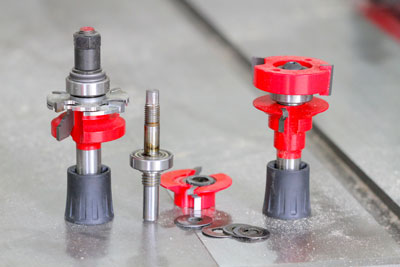 If you like the idea of making traditional mortise and tenon doors in solid wood, but also want the efficiency of a router, these unique bits are worth looking at. Unlike traditional router bits for making doors, these ones allow control of door frame thickness, tenon thickness and even tenon length. This is unique in the business right now, and quite an advantage. Conventional rail and stile bits are made to use only with standard 3/4”-thick wood, but that’s quite limiting. It’s too thick for small doors, and too thin for doors larger than about 48” tall. As with all equipment that offers added capability, the price you pay is a certain amount of added complexity. It will take you time to figure out how to get the most out of the PARS system. Freud has responded to this by publishing a detailed instruction package as part of the kit, and also as an online resource at www.freud.ca. Difference panel thickness is accommodated through the use of spacers, with different edge profiles in the PARS family. Once you get the hang of it, the system is easy to use.
If you like the idea of making traditional mortise and tenon doors in solid wood, but also want the efficiency of a router, these unique bits are worth looking at. Unlike traditional router bits for making doors, these ones allow control of door frame thickness, tenon thickness and even tenon length. This is unique in the business right now, and quite an advantage. Conventional rail and stile bits are made to use only with standard 3/4”-thick wood, but that’s quite limiting. It’s too thick for small doors, and too thin for doors larger than about 48” tall. As with all equipment that offers added capability, the price you pay is a certain amount of added complexity. It will take you time to figure out how to get the most out of the PARS system. Freud has responded to this by publishing a detailed instruction package as part of the kit, and also as an online resource at www.freud.ca. Difference panel thickness is accommodated through the use of spacers, with different edge profiles in the PARS family. Once you get the hang of it, the system is easy to use.